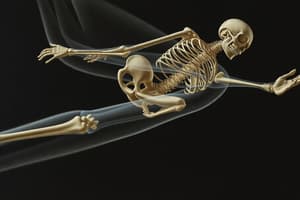Podcast
Questions and Answers
What are the basic osteokinematic movements?
What are the basic osteokinematic movements?
- Extension (correct)
- Adduction (correct)
- Flexion (correct)
- Translation
What does osteokinematics refer to?
What does osteokinematics refer to?
Movement of bones
Which of the following are arthrokinematic motions?
Which of the following are arthrokinematic motions?
- Spin (correct)
- Glide (correct)
- Twist
- Roll (correct)
What is the description of a roll in arthrokinematics?
What is the description of a roll in arthrokinematics?
What type of motion is depicted by sliding?
What type of motion is depicted by sliding?
The direction of the roll is the same as the direction of the moving bone.
The direction of the roll is the same as the direction of the moving bone.
What happens during a convex on concave motion?
What happens during a convex on concave motion?
What are the two types of movement described in arthrokinematics?
What are the two types of movement described in arthrokinematics?
What is necessary for full osteokinematic motion?
What is necessary for full osteokinematic motion?
What does the concave-convex law state?
What does the concave-convex law state?
What is an open kinematic chain?
What is an open kinematic chain?
What characterizes a closed kinematic chain?
What characterizes a closed kinematic chain?
What type of motion does angular movement refer to?
What type of motion does angular movement refer to?
Describe the spin motion in arthrokinematics.
Describe the spin motion in arthrokinematics.
Flashcards
Osteokinematics
Osteokinematics
These are the deliberate, voluntary movements we can make with our joints, like bending your elbow or raising your arm.
Arthrokinematics
Arthrokinematics
These movements focus on the way the bones move within the joint itself, involving rolling, sliding, and spinning.
Roll (Arthrokinematic Motion)
Roll (Arthrokinematic Motion)
One bone rotates on another, creating new contact points. Think of a tire rolling on the road.
Glide (Slide) (Arthrokinematic Motion)
Glide (Slide) (Arthrokinematic Motion)
Signup and view all the flashcards
Spin (Arthrokinematic Motion)
Spin (Arthrokinematic Motion)
Signup and view all the flashcards
Rolling Direction
Rolling Direction
Signup and view all the flashcards
Convex on Concave Dynamics
Convex on Concave Dynamics
Signup and view all the flashcards
Concave on Convex Dynamics
Concave on Convex Dynamics
Signup and view all the flashcards
Open Kinematic Chain
Open Kinematic Chain
Signup and view all the flashcards
Closed Kinematic Chain
Closed Kinematic Chain
Signup and view all the flashcards
Arthrokinematics for Osteokinematic Movement
Arthrokinematics for Osteokinematic Movement
Signup and view all the flashcards
Concave Surface Sliding
Concave Surface Sliding
Signup and view all the flashcards
Convex Surface Sliding
Convex Surface Sliding
Signup and view all the flashcards
Concave-Convex Law
Concave-Convex Law
Signup and view all the flashcards
Study Notes
Osteokinematics
- Refers to physiological movements of joints that can be performed voluntarily.
- Includes flexion, extension, adduction, abduction, and rotation.
- Involves gross movements of bones at joints primarily related to angular rotation.
Arthrokinematic Motions
- Comprises roll, glide (slide), and spin; most joint movements combine all three.
- Roll: rotary movement where one bone rolls on another, allowing new contact points.
- Slide: translatory movement, with one joint surface sliding over another; direction depends on the shape of surfaces.
- Spin: rotary movement where one body spins on another, maintaining contact at the same point.
Movement Dynamics
- Rolling always follows the direction of the moving bone, irrespective of bone shape (convex or concave).
- Convex on concave surface dynamics show opposite movements: the roll and glide take opposite directions.
- Concave on convex results in the same direction for both roll and glide.
- Points of contact differ across movements: rolls involve multiple points, slides involve a single point with multiple movement paths, and spins maintain contact at one point.
Kinematic Chains
- Open kinematic chain: distal segment is free, not fixed to an immovable surface.
- Closed kinematic chain: distal segment is fixed, allowing proximal segment freedom to move.
Arthrokinematics
- Essential for full osteokinematic motion: all three arthrokinematic motions (roll, glide, spin) must occur.
- The relationship between angular movement and sliding direction differs based on surface shapes:
- Concave surfaces move in the same direction as the angular movement.
- Convex surfaces slide in the opposite direction to the angular movement.
Concave-Convex Law
- Most diarthrodial joints consist of concave and convex surfaces, requiring coordinated roll and glide movements for function.
Angular Movement
- Defined as the increase or decrease in angles between two bones, including flexion, extension, abduction, adduction, and circumduction.
- Angular movements result from the interplay of rolls, spins, and slides.
Studying That Suits You
Use AI to generate personalized quizzes and flashcards to suit your learning preferences.




